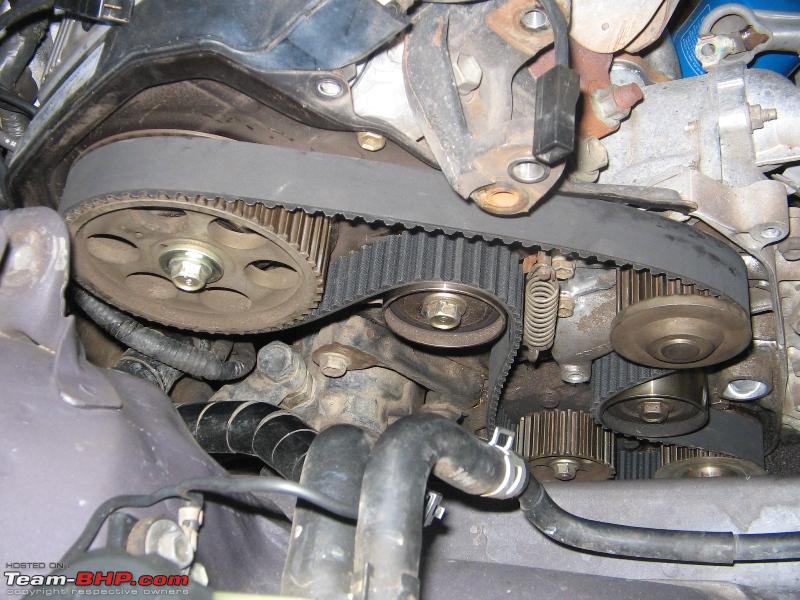Replacing the timing belt on a Toyota Camry can be a complex process and it’s important to follow the correct steps to ensure that the engine runs smoothly. Here are the general steps involved in setting the timing belt on a Toyota Camry:
- Remove the engine covers and accessories: Before you can access the timing belt you’ll need to remove the engine covers and any accessories that are in the way. This may include the alternator power steering pump and other components.
- Align the timing marks: Once you have access to the timing belt you’ll need to align the timing marks on the camshaft and crankshaft. This will ensure that the engine is in the correct position before you install the new timing belt.
- Remove the old timing belt: Carefully remove the old timing belt making sure not to damage any of the other components in the engine.
- Install the new timing belt: Install the new timing belt making sure that it is properly aligned with the timing marks on the camshaft and crankshaft.
- Adjust the tension: Once the new timing belt is installed you’ll need to adjust the tension to ensure that it is properly tensioned. This will help to prevent the timing belt from slipping or breaking.
- Reinstall the engine covers and accessories: Finally reinstall any engine covers and accessories that you removed earlier.
It’s important to note that the specific steps involved in setting the timing belt on a Toyota Camry may vary depending on the year and model of the vehicle. It’s always a good idea to consult the vehicle’s owner’s manual or a trusted mechanic for guidance. Additionally there are many helpful videos available online that can provide step-by-step instructions for setting the timing belt on a Toyota Camry
.




- What are the recommended intervals for replacing the timing belt on a Toyota Camry and are there any specific signs or symptoms that indicate it’s time for a replacement?
- Could you explain the step-by-step process for setting the timing belt on a Toyota Camry? Are there any special tools or precautions that should be taken during the procedure?
- Can the Timing Belt in a Toyota Rav4 be Set the Same Way as a Toyota Camry?
- In addition to setting the timing belt are there any other maintenance tasks or inspections that should be performed on the engine during this process to ensure optimal performance and longevity?
- Helpful Resources
What are the recommended intervals for replacing the timing belt on a Toyota Camry and are there any specific signs or symptoms that indicate it’s time for a replacement?
The recommended intervals for replacing the timing belt on a Toyota Camry can vary depending on the manufacturer and model of the vehicle. It is best to consult the owner’s manual for specific recommendations. However on average a timing belt replacement is typically needed every 60000 to 90000 miles.
While timing belts don’t usually give noticeable symptoms before they break there are some signs that may indicate it’s time for a replacement. These signs include:
- Ticking Noise: When the timing belt starts to wear out it may create a ticking sound inside the motor.
- Rough Idling: If your car begins to idle and vibrate roughly it could be a sign that the timing belt needs to be checked.
- Engine Issues: Problems starting engine stopping abruptly or not starting at all a significant loss of fuel economy and rough engine performance can all be indicators of a timing belt issue.
- Banging Noises: If you hear banging noises coming from the engine bay it could be a sign that the timing belt needs attention.
- Engine Misfires: Engine misfires difficulty starting smoke after starting the engine and loss of voltage can also be warning signs that it’s time to replace the timing belt.
It’s important to note that prevention is key when it comes to timing belts as they can break without any apparent indication of wear. Regularly replacing the timing belt the manufacturer’s recommendations can greatly reduce the chance of a broken timing belt and the potential damages it can cause.
Could you explain the step-by-step process for setting the timing belt on a Toyota Camry? Are there any special tools or precautions that should be taken during the procedure?
Here is a step-by-step guide for replacing the timing belt on a Toyota Camry:
- Remove the engine covers and accessories that are in the way of accessing the timing belt cover.
- Remove the timing belt cover by loosening the bolts that hold it in place.
- Rotate the crankshaft to align the timing marks on the camshaft and crankshaft sprockets. The timing marks should be aligned with the marks on the engine block.
- Loosen the tensioner pulley bolt and push the tensioner pulley away from the belt to release the tension on the belt.
- Remove the timing belt from the sprockets.
- Install the new timing belt onto the sprockets making sure the timing marks are still aligned.
- Tighten the tensioner pulley bolt to the manufacturer’s specifications to apply tension to the belt.
- Rotate the crankshaft two full revolutions to ensure the timing marks are still aligned.
- Reinstall the timing belt cover and any other accessories that were removed.
It is important to follow the manufacturer’s recommended torque specifications for all bolts and to use the correct tools for the job. Some special tools may be required such as a crankshaft pulley holder and a camshaft sprocket holder. It is also recommended to replace the water pump and other related components while replacing the timing belt as they may wear out at the same rate and can cause the belt to fail prematurely.
Can the Timing Belt in a Toyota Rav4 be Set the Same Way as a Toyota Camry?
Yes, the can be set the same way as a Toyota Camry. Both vehicles use timing chains rather than belts, which means they are designed to last the lifetime of the vehicle and do not require regular replacement like timing belts do.
In addition to setting the timing belt are there any other maintenance tasks or inspections that should be performed on the engine during this process to ensure optimal performance and longevity?
In addition to replacing the timing belt there are a few other maintenance tasks and inspections that can be performed on the engine to ensure optimal performance and longevity. These include:
- Water Pump Replacement: It is recommended to replace the water pump along with the timing belt. The water pump is responsible for circulating coolant throughout the engine to prevent overheating. Replacing it at the same time as the timing belt can save time and money in the long run.
- Inspect and Replace Other Components: When replacing the timing belt it is a good idea to inspect and potentially replace other components that are in close proximity or may be affected by the timing belt. This can include components such as the tensioner idler pulleys and camshaft seals.
- Check and Adjust Tension: Proper tension of the timing belt is crucial for its effective operation. During the replacement process it is important to ensure that the belt is properly tensioned the manufacturer’s specifications.
- Inspect and Replace Belts and Hoses: While working on the engine it is a good opportunity to inspect the condition of other belts and hoses. If any belts or hoses show signs of wear cracking or leaks they should be replaced to prevent potential issues in the future.
- Perform a General Engine Inspection: Take the time to visually inspect the engine for any signs of leaks damage or wear. Check for loose or damaged connections listen for any unusual noises and inspect the overall condition of the engine components.
Remember it is always recommended to consult the vehicle’s owner’s manual or seek professional advice when performing engine maintenance tasks. Following the manufacturer’s recommendations and guidelines will help ensure the best performance and longevity for your engine.
